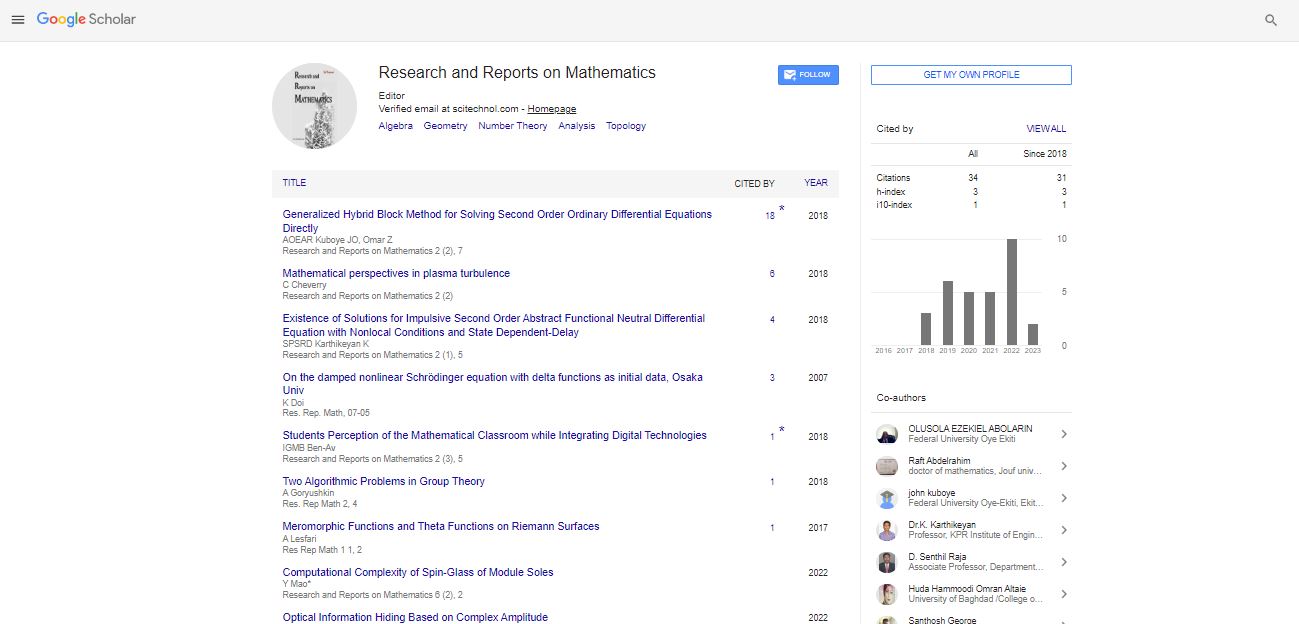Editorial, Res Rep Math Vol: 5 Issue: 2
LU Decomposition by Using ZNN Method and ZeaD Formulas
Shaik Nazeer*
Received Date: February 20, 2021; Accepted Date: February 23, 2021; Published Date: February 30, 2021
Citation: Nazeer S. (2019) LU Decomposition by Using ZNN Method and ZeaD Formulas. Res Rep Math 5:1.
Copyright: © All articles published in Research and Reports on Mathematics are the property of SciTechnol, and is protected by copyright laws. Copyright © 2021, SciTechnol, All Rights Reserved.
Abstract
In this paper, by employing the Zhang neural network (ZNN) method, effective continuous-time LU decomposition (CTLUD) model is firstly proposed, analyzed, and investigated for solving the time-varying LU decomposition problem. Then, for the convenience of digital hardware realization, this paper proposes three discrete-time models by using Euler, 4-instant Zhang et al. discretization (ZeaD), and 8-instant ZeaD formulas to discretize the proposed CTLUD model, respectively. Furthermore, the proposed models are wont to perform the LU decomposition of three time-varying matrices with different dimensions. Results indicate that the proposed models are effective for solving the time-varying LU decomposition problem, and therefore the 8-instant ZeaD LU decomposition model has the very best precision among the three discrete-time models.
Keywords: Calculating, Matrix, Determinant, Moreover, Decomposition, Crucial branch.
Introduction
The LU decomposition is usually described as decomposing a matrix into a unit lower triangular matrix (simply termed,) and an upper triangular matrix (simply termed,). Meanwhile, the matrix equals the merchandise of and, i.e., this is often also the origin of the name of LU decomposition. In numerical analysis, the LU decomposition is applied to solving linear systems, calculating the matrix determinant, and so on. Moreover, LU decomposition, as a crucial branch of matrix decompositions, also has many applications in science and engineering fields, like in multidimensional frequency estimation, array structures, and power flow algorithm. additionally, the LU decomposition-based techniques play a crucial role in solving various engineering problems. as an example , so as to get a secure and robust watermarking algorithm, the LU decomposition was utilized. Besides, the LU decomposition was employed to seek out the complex nonorthogonal joint diagonalization. For fast circuit analysis, the parallel sparse LU decomposition method was used. Therefore, solving the LU decomposition problem is extremely meaningful.
For solving the LU decomposition problem, many algorithms or methods were proposed. For instance, an LU-spatial decomposition method was proposed. The tactic uses a partitioning scheme to compute the LU decomposition instead of the specific inverse, which reduces the computational cost efficiently. A recursive LU decomposition algorithm was proposed. The tactic also can save the computation time but must make geometrical modifications to the precomputed scatterer. What’s more, as for the square matrix , a way to seek out the quasi-LU decomposition was proposed. The tactic can obtain the quasi-LU decomposition of a matrix though the matrix doesn’t have LU decomposition. However, those proposed algorithms or methods aren’t designed to seek out the LU decomposition of the time-varying matrix. Thus, for the time-varying matrix, those methods haven’t any significant advantages to seek out the LU decomposition and should have lag errors. For LU decomposition of the time-varying matrix, there’s little research while the time-varying problems are getting more and more important. Besides, a crucial application of time-varying LU decomposition is solving the angle-of-arrival (AoA) localization problem, which is according to the time-varying linear system and has been widely applied in various fields. The AoA localization problem are often formulated. Thus, employing a model or method (which can obtain the LU decomposition of the time-varying matrix in real time) can accelerate the solving progress of the AoA localization problem.
Due to the powerful capabilities in time-varying information science , Zhang neural network (ZNN) method has been applied to solving various time-varying problems. for instance , for locating real-time matrix root , a finite-time convergent ZNN was proposed. so as to unravel the time-varying matrix operation problem, a completely unique discrete-time ZNN was proposed. Therefore, the ZNN method is used to unravel the time-varying LU decomposition problem during this paper.
In the process of applying the ZNN method to solving the time-varying problems, a mistake function is made firstly. Then, by using the ZNN design formula, the error function is forced to converge to zero. Furthermore, the continuous-time model for solving the first problem is obtained. during this paper, the corresponding model is termed the continuous-time LU decomposition (CTLUD) model. additionally , by employing three one-step forward finite difference formulas (i.e., Euler, 4-instant Zhang et al. discretization (ZeaD), and 8-instant ZeaD formulas) to discretize the proposed CTLUD model, three corresponding discrete-time models are obtained.
The remainder of this paper consists of six sections. In Section 2, the matter formulation of the time-varying LU decomposition is presented. In Section 3, the planning process of the CTLUD model is presented. In Section 4, three discretization formulas are presented and corresponding discrete-time models are obtained. In Section 5, the proposed CTLUD model is used to perform LU decomposition of three time-varying matrices with different dimensions, and therefore the corresponding results are shown. In Section 6, the experiment results of three discrete-time models are presented. In Section 7, this paper is concluded. Before ending the introduction part, the most contributions of this paper are recapped as follows:
(1)Different from static LU decomposition problem analysis, this paper considers and analyzes the time-varying LU decomposition problem.
(2)An effective CTLUD model is proposed by employing the ZNN method, Kronecker product, and vectorization techniques.
(3)Three discrete-time LU decomposition models are obtained by employing three discretization formulas to discretize the proposed CTLUD model.
(4)Experiment results substantiate that the proposed models are effective for solving the time-varying LU decomposition problem.
 Spanish
Spanish  Chinese
Chinese  Russian
Russian  German
German  French
French  Japanese
Japanese  Portuguese
Portuguese  Hindi
Hindi 